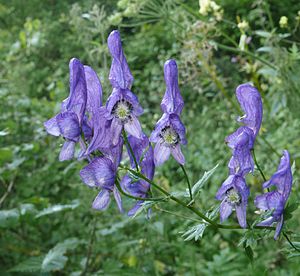Note: This is a project under development. The articles on this wiki are just being initiated and broadly incomplete. You can Help creating new pages.
Difference between revisions of "Main Page"
| Line 15: | Line 15: | ||
<div style="width:50%; float:right;"> | <div style="width:50%; float:right;"> | ||
{{featured content Main Page}} | {{featured content Main Page}} | ||
| + | [[File:(Nyctanthes arbor-tristis) flower at Madhurawada 01.JPG|thumb|right|''Parijata'']] | ||
</div> | </div> | ||
<br style="clear:both;"> | <br style="clear:both;"> | ||
Revision as of 13:39, 7 June 2018
Presently, there are 4,304 entries in this project.
This project is still in the initial stages and we welcome volunteers who're interested in helping build the project.
Getting started
News
- Android app available now.
From this week's featured page
Uses: Migraines, Headaches, Vomiting, Piles, Burning sensation, Perspiration problems, Burning sensation in the vagina.
Chemical Composition: Atisine, Aconitine, Atisenol, Atidine, Hetisine, Hetisinone, Banzolheteratisine, Histidine, F-dihydroatisine, Heteratisine and Several diterpene alkaloids such aheterophyllin, heterophyllisin, heterophyllidine, and hetidine.
Read more
 Medicinal plants (2256) |
Ayurvedic Herbs - Number of pages (2256) Document, read about several herbs used in Ayurveda. Contribute photos. |
 Drugs (489) |
Ayurvedic Medicine Document, read Ayurvedic Medicine available in the market presently. |
 Drug Manufacturers (158) |
Ayurvedic Drug Manufacturers List, add and edit various Drug manufacturers in Ayurveda. |
 Yoga (288) |
Yoga Document, read about Yoga, Patanjali's sutras and various asanas. |
 Traditions (53) |
Traditions in Ayurveda Read, document the traditions in Ayurveda. |
 Physiology (169) |
Physiology in Ayurveda Physiology in Ayurveda |
 Concepts (30) |
Concepts Concepts in Ayurveda. |
 Practices (11) |
Practices in Ayurveda Document, read about various practices in Ayurveda. |
 Prakriti (13) |
Prakriti in Ayurveda Prakriti in Ayurveda |
 Standards (13) |
Standards in Ayurveda Standards in Ayurveda |
Would you like to help develop this project? - Create an account and start editing!


